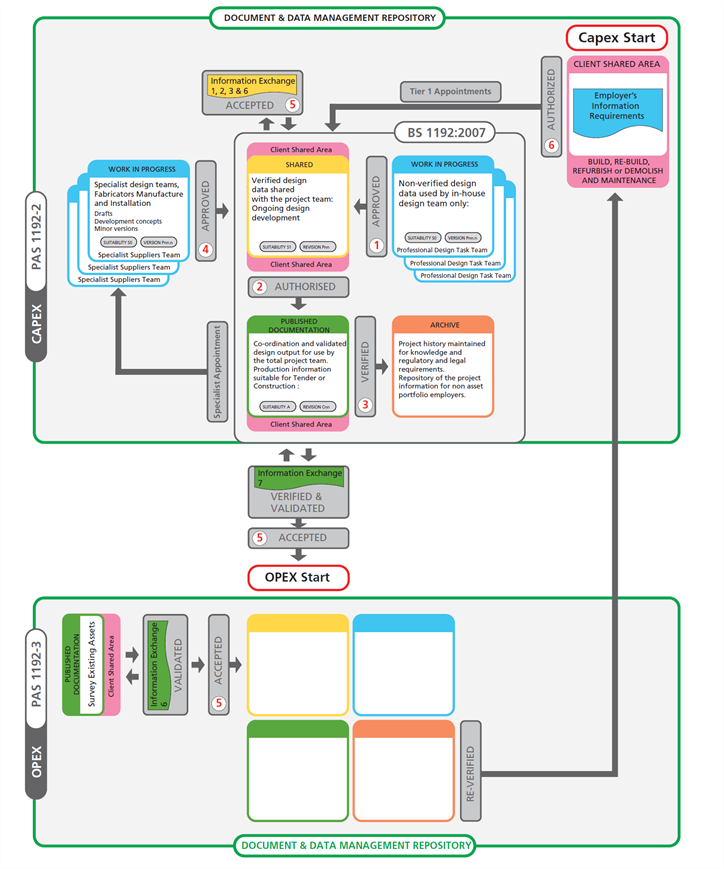What is a Common Data Environment (CDE)?
The BIM (Building Information Modeling) process requires setting up data-sharing procedures. Due to the frequency of exchanges and the amount of data shared, the use of e-mails is not enough, neither in terms of capacity nor in terms of traceability. This is why it is necessary to set up specific information management solutions for the “platform” type. We are then talking about Common Data Environment (CDE). A CDE centralizes the common data of the project and allows each of the actors to access it. The establishment of a CDE is a mandatory step for the implementation of BIM on a construction project. There are two aspects to take into account:
- On the one hand, an information management environment for managing data and documents. It can be a Drive or Dropbox file deposit server, an Electronic Document Management (EDM) solution, data integration solutions or a combination of these solutions. This is necessary to allow consistency of information and files, and to facilitate sharing and collaboration.
- On the other hand, a project management environment for the management of calendars, schedules, assignment of tasks, dashboards, etc. This aspect is necessary to allow the smooth running of the BIM process, in coherence with the project process.
Some solutions make it possible to manage the two aspects of data centralization and project management more or less completely such as Catenda Hub (previously Bimsync). Solutions covering both needs have the advantage of allowing integration and continuity between the work and project data, as well as simplifying the project solution environment. The choice of the CDE must be made in coherence with the environment of solutions of the actors of the project and the desired functionalities. It is important to take into account the fact that each actor may already have implemented a platform solution for the conduct of their projects. How to choose your CDE? You can download the CDE framework for free on this link.
See article: How to ensure effective communication in a Common Data Environment (CDE)?

Why the Common Data Environment is an essential element of the BIM Execution Plan?
In a collaborative exchange of models between different contributors, it is necessary to define a Common Data Environment which will be used for the needs of the project in coherence with the practices of the actors. The elements of the CDE are defined in the BIM Execution Plan on a project. The main elements defined in the BIM Execution Plan for the CDE are:
- Identify the environment of information management solutions within the project;
- Define the information management environment chosen for the project;
- Define the chosen project management environment (if it is different from the information management environment).
Then, all the rules are to be described in the BIM Execution Plan (BEP) or in specific documents annexed to it. The BIM Execution Plan must, therefore, define at least: environmental administrators and administration rules; the profiles of the actors and the access rights associated with the level of grain size required (directory, model, document, file, object, property); the access, collaboration and exchange procedures (frequency, mandatory or not, etc.) and more particularly the validation and dissemination circuits; control, validation and dissemination protocols for data, models, files and documents. You can download a BEP template for free here.
What Is The Purpose of using A Common Data Environment (CDE) in a building project, from design to maintenance?
The purpose of using a CDE in a construction project lies in its capacity to centralize all project-related information in a single source of truth and an accessible location. This centralization enhances collaboration and efficiency among project team members by ensuring all stakeholders are working with the same data. By using a CDE, project stakeholders can easily access and share relevant project information, including 3D models, documents, specifications, and schedules. This fosters a smoother, more efficient workflow, reducing the risk of misunderstandings or data loss.
A (CDE) encourages seamless collaboration between architects, engineers, contractors, and maintenance teams, as well as various tools utilizing the IFC and BCF. This promotes effective communication and coordination throughout all phases of the building project.
A CDE also provides a traceable audit trail of project activities. Every action, from data creation to modification or deletion during construction projects, is recorded. This allows for a clear understanding of how the project has evolved and can be invaluable in identifying bottlenecks, improving future workflows, and maintaining accountability among team members.
Furthermore, the use of a CDE helps to ensure compliance with ISO 19650, an international standard for managing information over the life cycle of a built asset using building information modeling (BIM). This standard emphasizes the need for a CDE to manage and disseminate data effectively.
A well-integrated CDE facilitates the smooth transition of relevant data and models from the construction phase to facility management, supporting ongoing maintenance and operations. By providing a holistic view of building information, a CDE contributes to optimizing facility performance over time, enabling effective issue resolution, continuous improvements, and increased longevity.
Finally, a CDE can offer improved data security, with robust encryption and strict access controls, ensuring that sensitive project data is kept secure while still being readily accessible to authorized team members and clients.
Common Data Environment Platform
Developed by Catenda, Catenda Hub serves as a common data environment (CDE) designed to assist construction and infrastructure stakeholders in project management. The open standards-based cloud platform facilitates information exchange, scheduling, planning, issue assignment, and centralization of all project data, including 2D plans, 3D models, and documents.
With Catenda Hub, you can:
- Enhance coordination through our issue management system.
- Visualize both 3D and 2D models.
- Enrich your models and documents.
Explore many more features that contribute to effective project management! Feel free to reach out to our sales team for assistance in implementing the system and optimizing Catenda Hub to enhance your project’s quality and performance.




